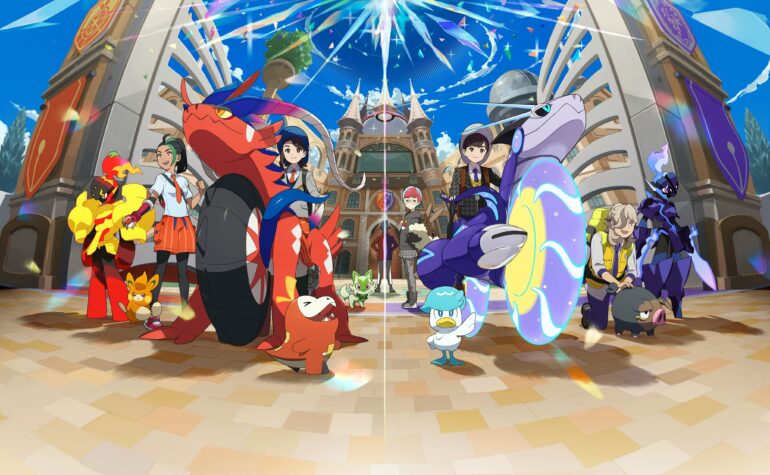Pokémon games progress at a sluggish pace. This might be annoying for fans hoping for the freshest and best, but it does make tracking how the games evolve over time simpler. Consider the series’ current obsession with providing gamers with an open universe. It began modestly, with Pokémon Sword and Shield providing a wild region for users to freely explore in 2019. Legends: Arceus, a spinoff that separated its planet into enormous regions rich with fauna and mysteries, debuted earlier this year. Violet and Scarlet are the first genuinely open-world games in the franchise’s history. They are the most expansive and diverse Pokémon games to date.
That size, however, comes at a cost, as the Nintendo Switch often struggles to keep up with the games. Even though this milestone for the series seems hampered at times, the excitement of exploration is never lost.
The games take set in the new Paldea area, which has a combination of Spanish and Portuguese characteristics and revolves around a local school for aspiring Pokémon trainers. It’s essentially the magical school cliche adapted for Pokémon – and it works quite well. You take on the role of a new transfer student, and after a few weeks of courses (which you happily don’t have to attend), you’re assigned an independent project with the subject “treasure hunt.” In actuality, you’re basically given free rein in the world to do anything you want.
This design makes more narrative sense than previous Pokémon games (sending youngsters out on a massive adventure with little to no preparation appears cruel in hindsight), but it also lets the game be much less restrictive. Violet and Scarlet feature three distinct story threads, each with its own set of tasks, and although you must complete them all to complete the game, you may do it in practically any sequence you choose.
The first thread will be immediately recognisable to long-time fans: you must tour the globe to defeat eight gym leaders, get their badges, and then compete in the Pokémon League to become champion. The others, on the other hand, are extremely different. One has you seeking for mythological “titans” throughout the area for research purposes, while the other has you storming the basecamps of a gang that seems to be behind some bullying issues at the school. Each has its own tale, and although they start off basic, they quickly become very intriguing – and strange. The game gets pleasantly bizarre by the time you reach the climactic final boss.
Violet and Scarlet are often amusing. One of the gym owners is a similar-obsessed streamer, while the other is a downtrodden salaryman. At one point, a lecturer will ask you to define cheugy. Later, there’s a rap fight with rhymes that rival Weird Al.
More essential than the tale, though, is that each of these songs provides you with something new to do. Of course, the foundation of Pokémon has not changed. Almost everything involves fighting or gathering creatures. However, the open-ended framework allows you much more flexibility and variation than in previous games.
Some of the adjustments are more effective than others. T the titan missions had a sense of mystery and peril to them, especially because they pitted you against some massive giant animals. The raids, on the other hand, seemed like a simplified version of Middle-earth: Shadow of Mordor, where you had to entice clan leaders out of hiding by participating in some very primitive pokémon combat.
There are other minor tasks and objectives, not the least of which is completing your Pokédex. Violet and Scarlet’s new animals are incredibly diverse. Some, like Lechonk (a fat pig) and Fidough (a dog with bagel ears), are cute and smart, but others are far less so. Some of the pokémon I caught were just animals. S some of the animals you’ll encounter at the conclusion of the novel are really unforgettable.
Some of the school-related additions were also appealing to me. While you’re largely learning in the field, you may still go to school and attend courses. If you attend enough of them, you will be given an exam to take. The sessions are engaging and often offer important information. However, there is a little Persona-style social structure in place where you may become closer to your teachers by attending school and conversing with them. Aside from some delightful tale moments, it doesn’t offer much, but it’s a pleasant touch.
Unfortunately, it’s evident that getting everything to fit on the Switch was a difficult feat. This is mostly seen in the images. It has some strange problems, such as Pokémon being trapped in walls or camera angles that made it hard to see in combat. And, although the primary people and pokémon are all good, the surroundings are often horrifying. In the backdrop, you’ll see figures who move like a slideshow and murky textures that appear to be from the PS2 era. There are rough edges, many pop-in difficulties, and locales that should be large, busy cities but instead seem lifeless. The menus seem to be regularly sluggish, which is annoying in a game where you spend a lot of time in them.
Of course, the Pokémon games have never been technological powerhouses. However, since Violet and Scarlet have a more contemporary construction, the seams are more visible. This is no longer a portable RPG; it’s a massive open universe on a home console (that you can also play on the go). However, it often seems and feels more old-fashioned than that lofty notion, significantly when magnified on your screen.
None of these flaws is deal breakers. You will have a lot of fun with Violet and Scarlet. If a Switch Pro does appear, let’s hope it arrives in time for the next Pokémon.
Violet and Scarlet will be available for the Nintendo Switch on November 18th.

